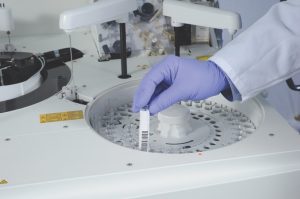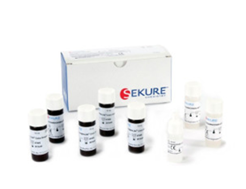For many people, good citizenship includes concern for the environment. It’s why they separate cardboard boxes for recycling, bring shopping bags to the grocery store, and convert to LED lights and energy-efficient appliances. Professionals in clinical chemistry share their concerns, and they demonstrate their commitment to sustainable medicine by working with vendors who implement “green chemistry principles” in their manufacturing processes and products.

Green chemistry refers to the design of chemical products and processes that reduce or eliminate the generation of hazardous substances.1 The concept applies across the life cycle of a chemical product, including its design, manufacture, use and ultimate disposal. It prevents pollution at the molecular level, results in source reduction, reduces the negative impact of chemical products and processes on human health and the environment, and leads to the development of chemical products and processes that reduce their intrinsic hazards.
The “12 principles of green chemistry” were introduced in 1998 by two chemists – John Warner and Paul Anastas, and they remain guiding principles for those in clinical chemistry and other disciplines.2 They include designing chemical syntheses to prevent waste, maximizing atom economy (so the final product contains the maximum proportion of the starting materials), using renewable feedstocks or starting materials when possible, and designing chemicals that degrade after use.3
Intent on reaching net zero greenhouse gas emissions by 2050, the UK Government is encouraging change across multiple areas of industry, including biomedical research.4 Laboratories are resource-intensive, using vast amounts of water and an average of five to 10 times more energy per square meter than standard office spaces. They make a significant contribution to the UK’s carbon footprint and are large consumers of single-use plastics. Significant steps have already been taken. For example, accreditation programs in the UK promote sustainable laboratory management and research practice, including the Laboratory Efficiency Assessment Framework (LEAF) and My Green Lab. Various carbon accounting tools have been developed, as have equipment-sharing and recycling initiatives.
Intent on reaching net zero greenhouse gas emissions by 2050, the UK Government is encouraging change across multiple areas of industry, including biomedical research
Pharmaceuticals
Some pharmaceutical firms have already embraced green chemistry principles. For example, drug maker Pfizer started doing so more than two decades ago.5 Reducing the use of nonrenewable raw materials, solvents and other reagents in favor of safer, environmentally preferable alternatives has been important parts of its strategy. Adopting analytical procedures that lead to reductions in material use is another. In one example, efforts in green chemistry were linked to 19% reduction in waste and 56% improved productivity compared with past drug production standards.
AstraZeneca reports it implements green chemistry principles to decrease the environmental impact of its Active Pharmaceutical Intermediate (API), that is, the active components of a pharmaceutical drug.6 The API often carries the largest environmental impact, especially in terms of carbon footprint. AstraZeneca believes that choosing the right catalyst is crucial to designing greener chemical reactions. Catalysts can enable reactions to proceed more quickly, enable chemistries that are otherwise impossible, and reduce the number of steps required to make the active component in its medicines.
And Bristol Myers Squibb received a 2021 Greener Reaction Conditions Award from the U.S. Environmental Protection Agency for developing a new, sustainable class of reagents.7 One key element of the technology is the use of phosphorous reagents in solid phase synthesis. Using phosphorus reduces the amount of reagent and solvent required and improves the stability of the reagent and intermediate products, leading to environmental benefits. These new reagents can be used with a variety of chemical and biological systems. For example, they allow rapid synthesis of products relevant to chemical catalyst and biological probes used in studying diseases, such as COVID-19.
Clinical Chemistry
SEKISUI Diagnostics produces a broad line of open channel reagents used to perform over 1.8 billion clinical chemistry tests each year on a wide range of market-leading branded chemistry analyzers.8 In its long-term vision, Vision 2030, SEKISUI Diagnostics identified "Innovation for the Earth" as its vision statement, i.e., planning to make future on earth more livable and create peace of mind to promote a sustainable and innovative society.9 For its efforts the company was included in the 2023 Global 100 Most Sustainable Corporations In The World Index by media and research firm Corporate Knights.
Environmental sustainability not only calls for a reduction of carbon emissions, but also waste materials and reagents.10 Biomedical research has characteristics that demand attention, including the preservation, handling, and disposal of biological samples and pharmaceutical products; and the intensity of resource use, including single-use plastics. Systemic or structural change may take time to enact and further studies are needed to close gaps in knowledge, but action can be taken now to approach eco-friendly medicine.
References
- Basics of Green Chemistry, U.S. Environmental Protection Agency
- Green Chemistry is Growing Up and Branching Out, TriplePundit
- Green Chemistry, Massachusetts Institute of Technology
- Enabling greener biomedical research, UK Research and Innovation (UKRI) Medical Research Council (MRC)
- Green Chemistry: A More Sustainable Approach to Medicine Development, Pfizer
- Striving for sustainable drug discovery using Green Chemistry, AstraZeneca
- Green Chemistry Challenge: 2021 Greener Reaction Conditions Award, U.S. Environmental Protection Agency
- For Core Laboratories, Sekisui Diagnostics
- SEKISUI again one of the 100 most sustainable companies in the world, SEKISUI
- Enabling greener biomedical research, UK Research and Innovation (UKRI) Medical Research Council (MRC)



Share Article